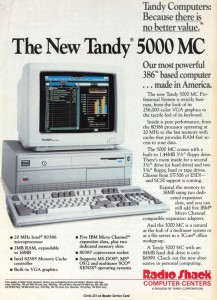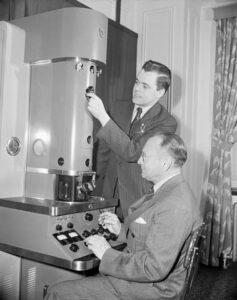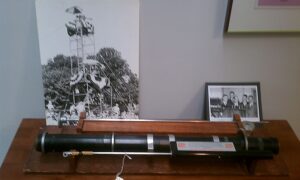A Crazy Day for Apple
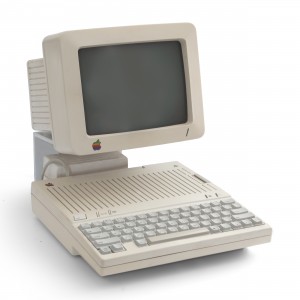 April 24, 1984
April 24, 1984
On the same day in 1984, Apple introduces the Apple IIc computer, announces Mac sales numbers, and discontinues the Apple III line.
The Apple IIc was Apple’s first attempt at a portable computer. Dealers place orders for more than 52,000 units on the first day. Apple also announces that over 60,000 Macs have been sold since their introduction in January that year. In contrast, the Apple III line only sold an estimated 120,000 units in the four years since it was introduced, losing Apple about $60 million dollars.
First YouTube Video
 April 23, 2005
April 23, 2005
The first video uploaded to YouTube, “Me at the zoo,” is posted on April 23, 2005 at 8:27 PM by co-founder Jawed Karim. For now being a piece of history, the video is actually pretty dumb.
Note to future entrepreneurs: what you do may be for posterity. Choose wisely.
Mosaic 1.0
 April 22, 1993
April 22, 1993
Version 1.0 of the web browser Mosaic is released by the National Center for Supercomputing Applications. It’s the first software to provide a graphical user interface for the emerging World Wide Web, including the ability to display inline graphics. The lead Mosaic developer is Marc Andreesen, one of the future founders of Netscape.
My first experience with the World Wide Web was in 1993 using Mosaic on a Mac in my dorm’s computer lab. I had no idea what I had discovered until a few months later.
IBM Licenses PC Patents
The Tandy Corporation holds a press conference to announce plans to build clones of IBM’s PS/2 system computers. The conference comes soon after IBM’s announcement that it would license patents on key PC technologies. IBM made this decision as they realized they were losing control of the “IBM-compatible” PC market and could make more money licensing the technologies. Within five years, IBM clones will become more popular than the original IBM machines themselves. Eventually IBM would leave the PC manufacturing business altogether, selling their PC division to Lenovo in 2005.
Windows 98 is Plug and … Whoa?
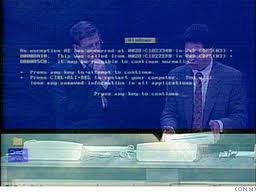 April 20, 1998
April 20, 1998
During the COMDEX Spring ’98 and Windows World shows in Chicago, a public demonstration of the soon-to-be released Windows 98 goes awry when Bill Gates’ assistant causes the operating system to crash after plugging in a scanner. Instead of showing the plug-and-play capabilities they were trying to demonstrate, a “Blue Screen of Death” is visible by the entire audience which immediately erupts in laughter. After several seconds, Bill Gates famously responded, “That must be why we’re not shipping Windows 98 yet.”
Ironically, the assistant, Chris Capossela, has moved up the executive ranks at Microsoft, all the way to Executive VP and Chief Marketing Officer. For Microsoft’s sake, hopefully he’ll present a much better marketing image then he did that fateful day!
Demonstration of First Practical Electron Microscope
Vladimir Zworykin, research director at RCA, holds a public demonstration of the first practical electron microscope. While the electron microscope had originally been invented in 1931, the first model was only able to produce a magnification of 400X. RCA’s model was the first to create a magnification of 100,000X, which was truly the first practical application of an electron microscope. This early model was 10 feet high and weighed half a ton. That thing was huge, especially considering it was meant to magnify really tiny things!
Vladimir Zworykin is also famous for being one of the inventors of the television.
Moore’s Law Published
 April 19, 1965
April 19, 1965
Electronics magazine publishes an article by Gordon Moore, head of research and development for Fairchild Semiconductor and future co-founder of Intel, on the future of semiconductor components. In the article, Moore predicts that transistor density on integrated circuits will double every eighteen months for “at least” the next ten years. This theory will eventually come to be known as Moore’s Law and has largely held true to this day. Controversy exists over whether Moore’s Law remains applicable, however time will tell just how long Moore’s Law will continue to remain true.
Zoom Lenses Come to TV
The first public demonstration of a prototype Zoomar lens is conducted inside Studio 3H at NBC’s Rockefeller Plaza headquarters in New York City. Invented by Dr. Frank G. Back, and promoted by investor film and television producer Jerry Fairbanks, the Zoomar lens would become the first commercially successful zoom lens. A version for film cameras would first be used by Paramount later that year to cover the 1947 World Series for newsreel production. The ability to use zoom lenses allowed for less expensive TV productions and also made television sports broadcasts more interesting and feasible. By the end of the decade, Zoomar lenses were in use in nearly one-third of television stations in the United States at the time. As new TV stations were popping up quickly during this era, the fact that by 1957 more than half of the TV stations then in operation owned Zoomar lenses was even more impressive.
First Megabit Chip in Commercial Product
Newspapers report that IBM’s Model 3090 mainframe has become the first commercial computer to use a megabit memory chip, 4 times the storage capacity of the then current generation of 256 kilobit chips. To give context to that amount of storage, it was reported that a megabit chip could store over 1 million bits of data, which translated to about about 100 double-spaced typewritten pages. At the time most personal computers were still using 64 kilobit memory chips.
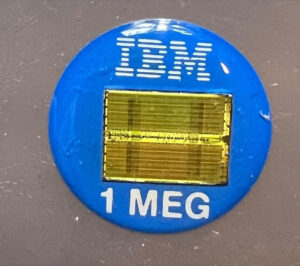 IBM wanted to make the announcement for two big reasons. First, the use of higher density memory could allow them to make their mainframe computers smaller, which would save their customers cost in floor space. But perhaps more importantly, they wanted to show that American technology companies in general and IBM in specific could keep up with Japanese companies in the highly competitive semiconductor market of the time. Lower-cost Japanese firms had captured 85% of the DRAM market and Fujitsu, Hitachi, Mitsubishi, NEC, and Toshiba were set to begin shipping megabit memory of their own. IBM was attempting to shed their reputation as being slow and stodgy as compared to the upstart Japanese. They even made promotional buttons with actual 1 megabit chips!
IBM wanted to make the announcement for two big reasons. First, the use of higher density memory could allow them to make their mainframe computers smaller, which would save their customers cost in floor space. But perhaps more importantly, they wanted to show that American technology companies in general and IBM in specific could keep up with Japanese companies in the highly competitive semiconductor market of the time. Lower-cost Japanese firms had captured 85% of the DRAM market and Fujitsu, Hitachi, Mitsubishi, NEC, and Toshiba were set to begin shipping megabit memory of their own. IBM was attempting to shed their reputation as being slow and stodgy as compared to the upstart Japanese. They even made promotional buttons with actual 1 megabit chips!
Osborne Executive Introduced
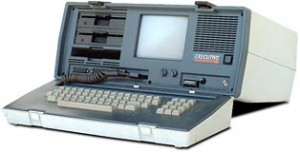 April 18, 1983
April 18, 1983
The Osborne Computer Corporation officially announced the Osborne Executive portable computer, the follow-up to its extremely successful Osborne 1. This is the computer that according to lore, took down the company. Known as the Osborne Effect, the legend is that by leaking the announcement of this computer earlier in the year, dealers cancelled all orders for the Osborne 1, effectively destroying the company’s cashflow and hindering operations going forward. This resulted in the cancellation of the company’s IPO and eventually to bankruptcy.
The reality may not be so simple, but my research shows that the Osborne Effect may have been a contributing cause to the company’s demise, along with the rise of competitors, the introduction of the IBM PC, and mismanagement by the company’s president, brought in by investors to provide “adult supervision”.

